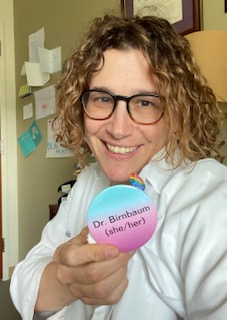
Dr. Birnbaum
As many of you know, June is Pride Month, a time when we come together to support the LGBTQ+ community. Most often it is marked by parades and festivals. I am hoping to use this month to raise awareness around caring for transgender patients.
Many doctors may say they don’t have any transgender patients in their practices, but the truth is you may not know. Although many electronic medical records, such as Epic, have space to put in pronouns and names, some used in private practices do not.
Looks Can Be Deceptive
This past week I met a new patient. He had a female name and long hair. I have been introducing myself to new patients, especially younger ones, with “Hi, I’m Dr. Birnbaum. My pronouns are she/her. How about you?”
When this patient told me his pronouns were he/him, I asked his name. It was a male name rather than the birth name on his insurance card and chart (often referred to as a dead name in the transgender community). Had I not asked, we might have gone through an entire appointment without me knowing. This patient has not been able to access gender-affirming care yet.
For many transgender and non-binary patients, the anxiety of registering for a medical appointment, having that name called out when waiting to be roomed, and wondering how and if gender will be part of a discussion is so overwhelming they don’t seek care at all.
How do I know this?
Getting Personal
This past August, my 11-year-old told us he felt like he was more a boy than a girl. Within weeks, he had cut his hair short, changed his name and asked us to begin using he/him pronouns. My child was now a part of a vulnerable patient population, and I had embarked on one of the steepest learning curves ever.
We are extremely fortunate to live where we do, have access to the Children’s Hospital of Philadelphia (CHOP) gender clinic and have family that is open to him. He attends a very inclusive school, and swims and plays basketball with supportive teams. This has not been easy, but my son feels affirmed, and we are working hard to support him.
There has been anxiety along the way. One huge hurdle is waiting for his name to be called at various doctors’ and dentists’ offices, laboratories, etc. I usually call ahead to remind them. All forms I have come across have places for him to identify, but inevitably mistakes still happen and cause him embarrassment and sadness. The statistics about rates of depression, anxiety and suicide in this population are both abysmal and alarming.


